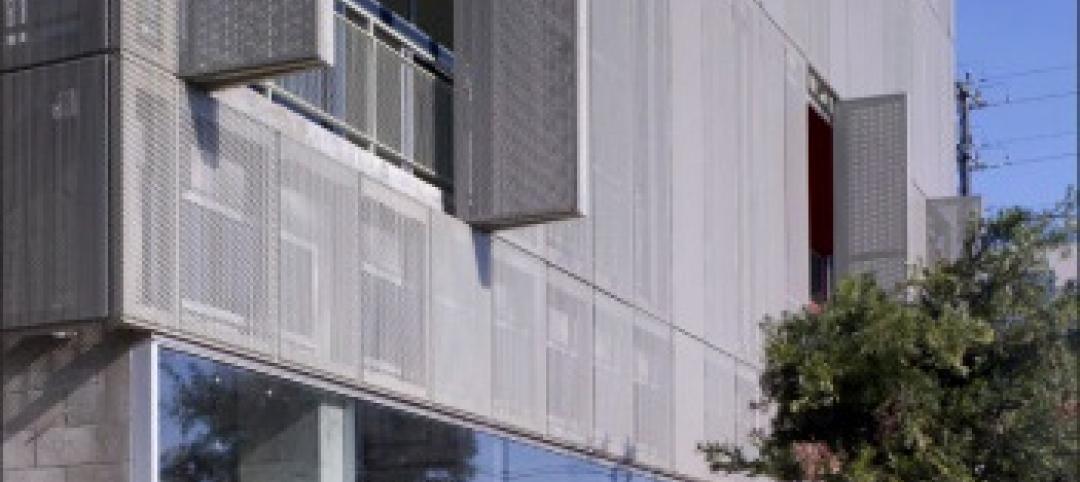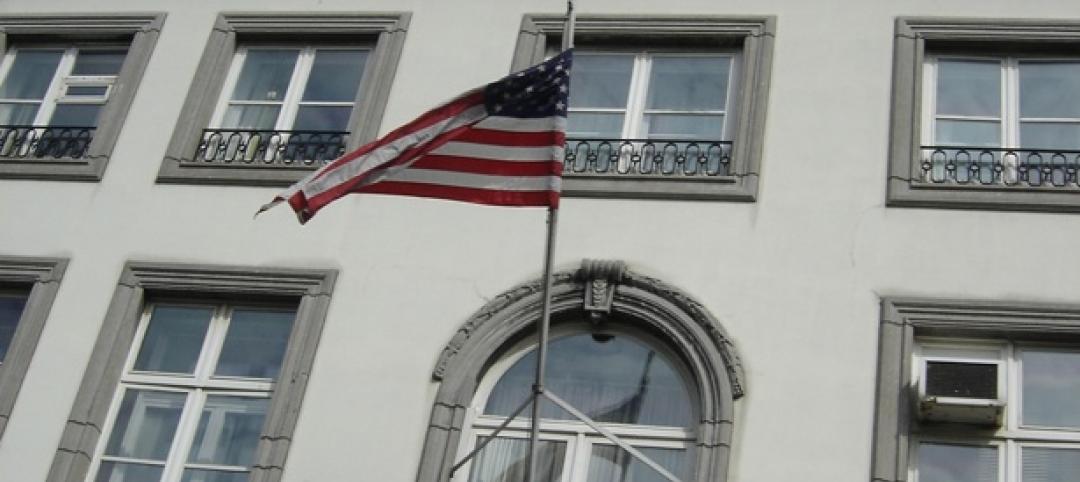“This building may look very cool and modern, but it’s all about performance,” says Marc Butler, CEO and president of J.R. Butler Inc., the Denver-based glazing contractor that helped produce nearly 600 high-performance windows for the U.S. Department of Energy’s new National Renewable Energy Laboratory, near Golden, Colo. From the outset, the client required its 222,000-sf facility to meet the highest performance goals attainable: LEED Platinum, net-zero-energy use, and energy performance 50% better than ASHRAE 90.1 2004. “Those are the three things we made all the decisions around,” says Butler.
It’s ambitious to take on any project with such aggressive energy-efficiency goals, but to move ahead knowing that a significant amount of the building would be punched full of window openings—the building has a wall-to-floor square footage ratio of 4:1—is a prospect many Building Teams would gladly pass up. Throw in a couple additional challenges, such as a tight $64 million budget and a 500-page design-build contract with 50% of the fee at risk if terms weren’t satisfied, and the Building Team of RNL (architect), Stantec (engineer), Haselden Construction (GC), and J.R. Butler had their work cut out for them.
Their solutions for the building’s performance requirements involved the use of innovative window products to optimize and manage daylighting and views and control natural ventilation and unwanted heat gain.
“Daylighting and solar energy are at the core of the building,” says Philip Macey, AIA, design-build project manager for Haselden. “Free lighting is the most important thing a designer and contractor can give a building owner.” The facility’s H-shaped layout, with its two narrow 60-foot-wide wings, ensures that no workstation is more than 30 feet from a window—in a building designed for 800 employees. “During an average day, you should never have to turn on the lights,” says Butler.
Daylighting enters the building from all sides, meaning each façade has numerous openings—a design hardly conducive to a tight, super-efficient building. Window units had to plug potential leaks. “The R-value in the walls was huge, which meant the R-value in the glass had to be huge,” says glazing contractor Butler. “It’s a significant challenge for glass to give you good insulation value.” Butler, whose firm has a license agreement to unitize for Wausau Windows and Wall Systems, specified Wausau’s 4250 Series and created a SuperWall system with help from SageGlass, Viracon, and Linetec using energy and light modeling data from Stantec.
The thermal modeling process lasted about 15 months. There was so much data to be crunched that Butler says it took a dedicated computer bank three weeks to spit out supposedly “final” results each time a change was made. “Every time we thought we were good and ready to order the windows, something else would bump the performance of the window,” says Butler. “The balancing act was crazy.”
As a result of the complex modeling, eight different types of glass were specified to help balance light, U-value, and shade coefficient. Wausau’s high-performance aluminum frames (with 70% recycled content using secondary billet) were fitted with triple-pane glazing that features Viracon low-e coatings (sometimes two or three different coatings). In some instances, electrochromically tintable glass (from Sage Electrochromics), which darkens when voltage is applied to it, was used. Linetec finished the aluminum frames in a silver-hued mica Kynar coating and supplied the thermal barrier system. Fabrication of the custom windows took about 10 weeks, with both Wausau and J.R. Butler manufacturing the units.
Wausau also constructed custom sunshades, called bonnets, to box the windows, adding both a distinguishing architectural element and additional shading. “The sunshades give people the ability to look out and see the full Colorado landscape but without having direct sunlight in their face,” says Butler. “In our studies of the sun, when you get that spring and fall and winter sun, the sidepieces block that out. When you have high summer sun, the top shade blocks that out.”
The problem with using all that super high-performance glazing and additional shading devices is that it reduces visible light transmittance, which conflicted with the client’s wish for interiors flooded with natural light. To compensate, clerestory windows were installed above the bonnets and fitted with fixed, mirrored light louvers between the panes that reflect light upward, bouncing it off the ceiling and funneling it deep into the building—an average 20 to 30 feet inside. The Building Team also employed 13-foot-high ceilings, workstation furniture with low walls, and bright interior paint colors to keep interiors bright. “It got to the point where we had to make sure interior light wasn’t too overwhelming,” says Butler.
The operable clerestory windows are programmed to automatically open at night to purge heat buildup and cool the building. “It’s a smart alternative to having the air-conditioning kick on,” says Butler. Those operable windows almost never made it beyond the drawing board, however, because the DOE worried about the building being targeted for a bomb or poison gas attack and being caught with the windows open. However, the Building Team was able to obtain a special code variance, and numerous safeguards were put in place to protect against such an incident.
The custom windows and installation were costly, with J.R. Butler being the project’s second largest subcontractor. Butler acknowledges that while the scope of work was appropriate for this particular client, “it’s still very expensive for the private sector, but they can learn from this technology” and incorporate ideas into their projects as budgets permit.
The National Renewable Energy Laboratory’s Sustainable Features
• High-efficiency windows
• Precast CMU
• Radiant heating and cooling
• Underfloor ventilation
• High-efficiency computers, monitors, and other office equipment
• Transpired solar collectors
• On-site solar energy system
• Use of recycled and reclaimed materials, including aggregate from an airport runway and structural steel columns from natural gas piping
Related Stories
| Apr 26, 2011
Ed Mazria on how NYC can achieve carbon neutrality in buildings by 2030
The New York Chapter of the American Institute of Architects invited Mr. Mazria to present a keynote lecture to launch its 2030 training program. In advance of that lecture, Jacob Slevin, co-founder of DesignerPages.com and a contributor to The Huffington Post, interviewed Mazria about creating a sustainable vision for the future and how New York City's architects and designers can rise to the occasion.
| Apr 26, 2011
Video: Are China's ghost cities a bubble waiting to burst?
It's estimated that 10 new cities are being built in China every year, but many are virtually deserted. Retail space remains empty and hundreds of apartments are vacant, but the Chinese government is more concerned with maintaining economic growth—and building cities is one way of achieving that goal.
| Apr 25, 2011
Earn $300 million by NOT hiring Frank Gehry
An Iowa philanthropist and architecture aficionado—who wishes to remain anonymous—is offering a $300 million “reward” to any city anywhere in the world that’s brave enough to hire someone other than Frank Gehry to design its new art museum.
| Apr 20, 2011
Marketing firm Funtion: to host “Construct. Build. Evolve.”
Function:, an integrated marketing agency that specializes in reaching the architecture, building and design community, is hosting an interactive art event, “Construct. Build. Evolve.” in Atlanta’s Piedmont Park on Thursday April 21, 2011 at 11:00AM EDT. During the event attendees will be asked to answer the question, “how would you build the future?” to rouse dialogue and discover fresh ideas for the future of the built environment.
| Apr 20, 2011
Architecture Billings Index: new projects inquiry index up significantly from February
The American Institute of Architects (AIA) reported the March ABI score was 50.5, a negligible decrease from a reading of 50.6 the previous month. This score reflects a modest increase in demand for design services (any score above 50 indicates an increase in billings). The new projects inquiry index was 58.7, up significantly from a mark of 56.4 in February.
| Apr 19, 2011
What are the 15 most-watched construction and engineering stocks?
According to Motley Fool, a multimedia financial services company, the most-watched construction and engineering stock is Fluor (NYSE: FLR), which ranks #1 on BD+C’s Giants 300 engineering list with $1.994 billion in revenue in 2009. Check out the 14 other most-watched A/E stocks.
| Apr 19, 2011
AIA announces top 10 green Projects for 2011
The American Institute of Architects Committee on the Environment announced its Top 10 Green Projects for 2011. Among the winners: Cherokee Studios in Los Angeles, the Department of Energy's National Renewable Energy Laboratory in Golden, Colo., and the Vancouver Convention Centre West in Vancouver, British Columbia.
| Apr 18, 2011
Greening and Upgrading Today’s Vertical Transport Systems
Earn 1.0 AIA/CES HSW/SD learning units by studying this article and passing the online exam.
| Apr 14, 2011
U.S. embassies on a mission to green the world's buildings
The U.S. is putting greater emphasis on greening its worldwide portfolio of embassies. The U.S. State Department-affiliated League of Green Embassies already has 70 U.S. embassies undergoing efforts to reduce their environmental impact, and the organization plans to increase that number to more than 100 by the end of the year.













